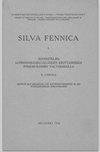机载双波长波形激光雷达提高了北方阔叶树和针叶树的树种分类精度
IF 1.7
3区 农林科学
Q2 FORESTRY
引用次数: 1
摘要
树种识别是遥感应用中的一个瓶颈。波形激光雷达已被证明具有优于离散返回观测的潜力,我们评估了两波长波形数据的组合是否可以进一步改进。在芬兰南部Hyytiälä森林中发现的共2532棵树,代表7个活的和死的针叶树和落叶种类。激光雷达数据由两个单波长传感器获取。1064 nm和1550 nm的数据经过辐射校正,使用雷达方程实现距离归一化。脉冲通过树冠进行追踪,并通过应用3D树冠模型,将返回波形分配给每棵树。树冠模型和地形模型使波形进一步分裂为代表树冠、林下植被和地面部分的地层。每个返回脉冲提取不同的几何和辐射波形属性,并汇总为树级均值和标准差特征。我们分析了树的大小对特征的影响、特征之间的相关性以及波形特征的种间差异。利用f检验和随机森林算法推导了物种分类的特征重要度。合并1064-nm和1550-nm特征时,总体准确率(7类74→83%,4类88→91%)显著提高。大多数特征对树的大小并不是不变的,并且依赖关系在物种和激光雷达波长之间存在差异。这种差异可能是由树皮反射率、树顶附近高度生长引起的结构变化以及老树的叶子密度等因素造成的。本文章由计算机程序翻译,如有差异,请以英文原文为准。
Airborne dual-wavelength waveform LiDAR improves species classification accuracy of boreal broadleaved and coniferous trees
Tree species identification constitutes a bottleneck in remote sensing applications. Waveform LiDAR has been shown to offer potential over discrete-return observations, and we assessed if the combination of two-wavelength waveform data can lead to further improvements. A total of 2532 trees representing seven living and dead conifer and deciduous species classes found in Hyytiälä forests in southern Finland were included in the experiments. LiDAR data was acquired by two single-wavelength sensors. The 1064-nm and 1550-nm data were radiometrically corrected to enable range-normalization using the radar equation. Pulses were traced through the canopy, and by applying 3D crown models, the return waveforms were assigned to individual trees. Crown models and a terrain model enabled a further split of the waveforms to strata representing the crown, understory and ground segments. Different geometric and radiometric waveform attributes were extracted per return pulse and aggregated to tree-level mean and standard deviation features. We analyzed the effect of tree size on the features, the correlation between features and the between-species differences of the waveform features. Feature importance for species classification was derived using F-test and the Random Forest algorithm. Classification tests showed significant improvement in overall accuracy (74→83% with 7 classes, 88→91% with 4 classes) when the 1064-nm and 1550-nm features were merged. Most features were not invariant to tree size, and the dependencies differed between species and LiDAR wavelength. The differences were likely driven by factors such as bark reflectance, height growth induced structural changes near the treetop as well as foliage density in old trees.
求助全文
通过发布文献求助,成功后即可免费获取论文全文。
去求助
来源期刊

Silva Fennica
农林科学-林学
CiteScore
3.50
自引率
11.10%
发文量
21
审稿时长
3 months
期刊介绍:
Silva Fennica publishes significant new knowledge on forest sciences. The scope covers research on forestry and forest ecosystems. Silva Fennica aims to increase understanding on forest ecosystems, and sustainable use and conservation of forest resources. Use of forest resources includes all aspects of forestry containing biomass-based and non-timber products, economic and social factors etc.
 求助内容:
求助内容: 应助结果提醒方式:
应助结果提醒方式:


